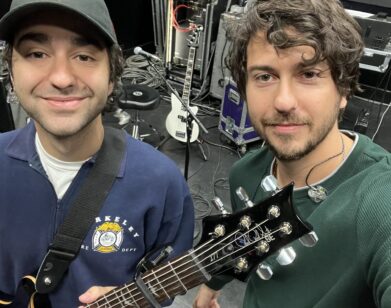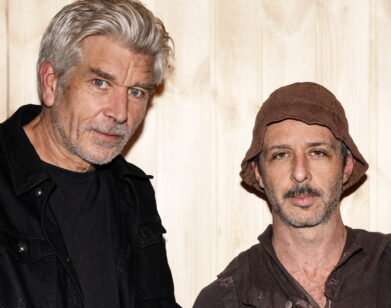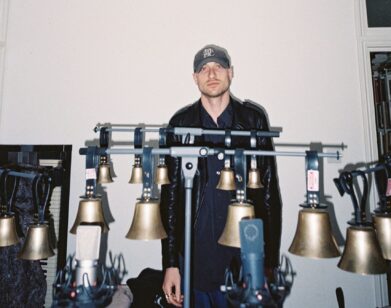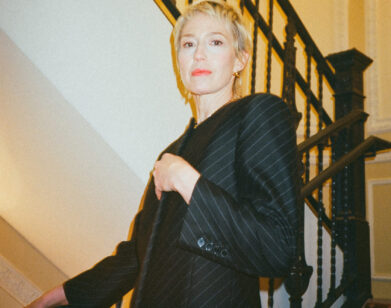Dexter Bullard Graces Broadway
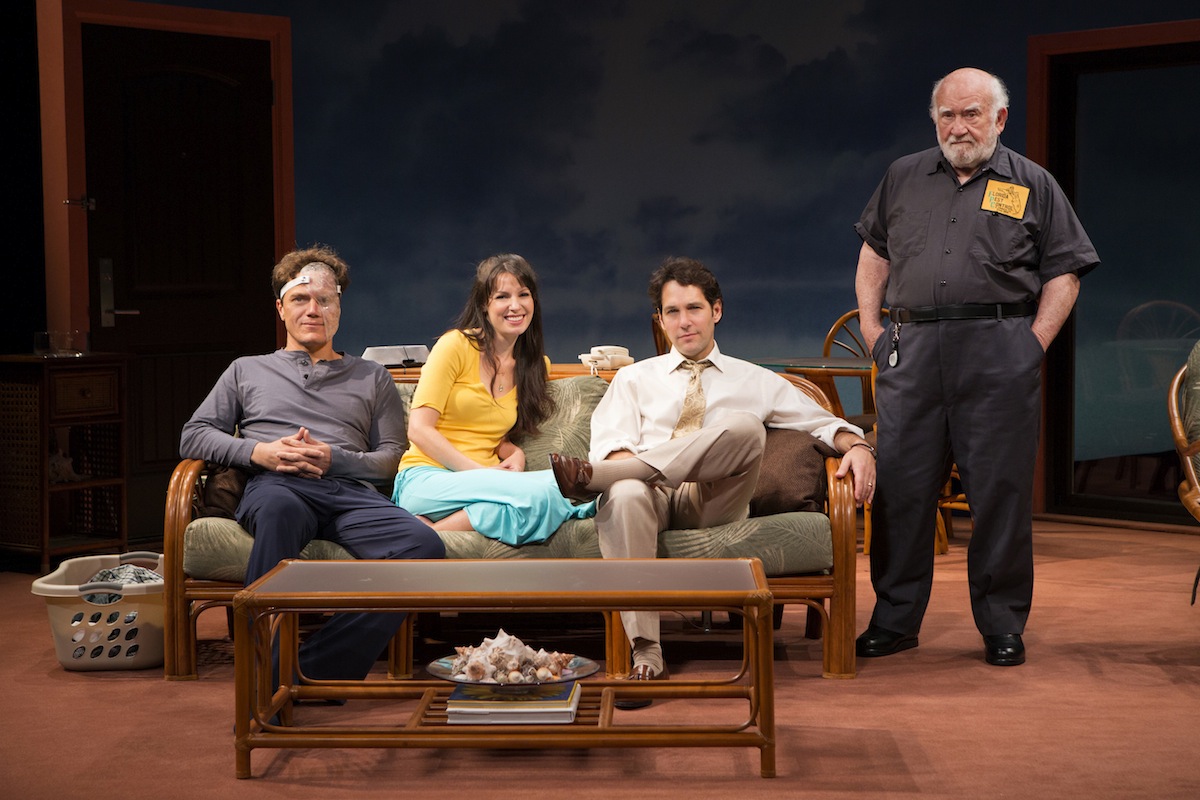
ABOVE: GRACE‘S MICHAEL SHANNON, KATE ARRINGTON, PAUL RUDD, AND ED ASNER. IMAGE COURTESY OF JOAN MARCUS
A revolving set, an all-star cast, controversial subject matter, and legendary curmudgeon Ed Asner’s return to the stage after 23 years: It may be his first visit to the Great White Way, but Chicago theater director Dexter Bullard is not afraid of a challenge. In his Broadway debut, Bullard directs Grace, which opened last Thursday, at the Cort Theatre, guiding television and film actors Asner, Paul Rudd, Michael Shannon, and Kate Arrington through emotional and metaphysical quandaries on stage.
Written by Craig Wright (television’s Six Feet Under), the play is a dark comedy about a young fundamentalist Christian couple (Rudd and Arrington) who begin to question their faith after being confronted by a failing business and an agnostic next-door neighbor (Shannon). This is Bullard’s second time directing Grace, the first being an early 2006 production of the play at the Northlight Theater in Skokie, Illinois, which also starred Shannon. Since that time, Bullard, Wright, and Shannon have become something of a theatrical tour de force, collaborating on several shows, including the critically acclaimed 2010 off-Broadway production of Mistakes Were Made.
We spoke to the director as he got ready to return to classes at DePaul University, where he is a professor, about his relationship with Wright, the New York state mind, and how acting is “really fucking hard.”
LAURIE KAMENS: How does it feel to be back home?
DEXTER BULLARD: It feels weird and strange and quiet. What happened to all the energy of New York?
KAMENS: Well, now that you’ve had some time to reflect, how are you feeling about the whole experience?
BULLARD: It was thrilling. The thing I miss the most are the people involved with the project. We worked furiously, everybody put their nose[s] to the grindstone, and I feel like what I got, which [was] not really what I expected from Broadway, is a really rich artistic experience. Also I thought that the vision that I introduced a few months ago came very close to how I imagined it.
KAMENS: But this isn’t the first time you’ve directed this show. When you first directed Grace back in 2006, how did you get involved with the project?
BULLARD: The artistic director of Northlight, BJ Jones, wanted to work me into the season because he had seen [my 2004 production of Tracy Letts’] Bug, and he said, “Here’s this play that I saw at Wooly Mammoth in 2005, I think it’s pretty great,” and I said, “I think it’s pretty great,” and he put me in touch with Craig [Wright].
KAMENS: When you initially worked on the play, did you ever envision it ending up on Broadway?
BULLARD: No. I thought it was a brilliant play, and I’ve always believed that Craig is a brilliant writer so I’m not surprised that something like this would land as hard as it does. I mean, Craig has a fantastic career. Michael [Shannon] has a fantastic career. The collaborations that built [Grace], I was very invested in right away. We worked [together] again on Lady and Mistakes Were Made, [and] that ongoing relationship has been growing and growing. So that was one of the pleasures of working on [the play]. It may have been brought to Broadway, but what wasn’t different was still working with Michael and Craig. We knew there was excellent work back then that would be worth having on Broadway for sure.
KAMENS: When you initially read the play six years ago, what was it that attracted you to the material?
BULLARD: The focus on the story, the use of time backwards and forwards, the use of overlapping spaces, I thought that was all, not just clever, but to me represented a theatrical metaphor of what was going on in the love triangle and the progress of the story. And also the humor, but mostly the emotional transformations to me are the most interesting thing about Grace, and are something I worked on with the actors probably more than anything else. That is, each one of these four people changes dramatically over 90 minutes.
Also, the first time I read it I had this image of the [set] revolving, because Craig has this play structure that says, “Play Stops,” so to me it felt like clockwork, like it was a story that was carried foreword through space. That’s what grabbed me about the play, the interesting conceits of time and space that are part of what [it’s] about.
KAMENS: How has the play changed since you first directed it?
BULLARD: Oh my—it’s not different with Hamlet or anything else, you can direct it 10 times, but there’s new people—who’s playing Hamlet is largely what’s different. In other words, the text stays the same, though the play unfortunately had quite a bit of rewrites since Northlight. Craig worked quite a bit on the play to make it feel more dynamic for Broadway, and we had brand-new designers except for [costume designer] Tif [Bullard] and [make-up designer] Nan [Zabriskie]. They all brought a very different sensibility and accuracy to the details of the production.
The good thing about doing a previous production is that I just have a better knowledge of the play. It’s like rock climbing. The first time you’re just wondering where are the footholds and the handles. The second time you do it, you can enjoy the hike for what it is. So there’s footprints to follow, but no way did I feel like I was taking the Northlight production and adapting it to Broadway. Some ideas came through, but they were translated through some different people in really brilliant ways.
KAMENS: The play deals so much with larger philosophical and metaphysical issues. Were there new things you discovered personally this time around?
BULLARD: On the level of faith and Christianity, I [recently] went back to my home church, which is an Episcopalian church in Carlyle, PA, with my father, who’s a devout Christian. And sitting in church, I felt more connected, and it’s not just what [Michael Shannon’s character] Sam says, that [the concept of Jesus] is [just] way to extort money [from people]. There was a sense of community, a sense of identity in me that the play helped me think about. I could never say that I’m a Christian right now, but I can definitely say I came from a Christian background, I know many devout Christians, and I can respect everything about that.
KAMENS: This being your first Broadway show, what was the rehearsal process like?
BULLARD: I wouldn’t change my process for Broadway or anything else. When it comes down to it, actors have to live in the terms of the given circumstances, or as Michael [Shannon] likes to say, we have to live as these people. It’s expressed through just the tiniest little dots of information, but our rehearsal process was about taking those dots and putting them on to a real human and having them explain through their artistry what does that mean. We had to remember that as much as the play is about cosmic dimensions, Craig always writes plays that have a mundane base. It’s kind of like painting, I guess, you have to work on each brushstroke, [and] if we can start to have their humanity come through, then we get that lovely indivisible feeling with the audience that they can’t help but notice that lives are being lived in front of them.
KAMENS: On opening night, Ed Asner playfully said in an interview that you were a slave driver. Is that really true?
BULLARD: From his prospective, probably yes, but anyone else knows that I’m one of the nicest guys out there. I’m known as a Zen director; I give a lot of trust and a lot of faith. I’m not in a rush to get things right, and I particularly know that the number one enemy of theater is fear. Fear and self-consciousness and judgment are the things that are opposite to impulse and imagination. So I try to send a blanketing calm feeling, just like a coach on a basketball team; no matter where we are, it’s okay, we’re just three seconds away from having it solved.
Acting is hard, it’s really fucking hard, so that makes me a slave driver because I’m having to have them do something hard over and over again, but I think my personal style is actually much more sort of gentle and not anxious.
KAMENS: We actually spoke with Kate Arrington, and she gave us some insight into your rehearsals—she mentioned that for the portions of the play in which the action goes in reverse, the cast watched a videotape of their acting on rewind. Was that your idea?
BULLARD: Yes, I wanted the physical detail of the working backwards to be really gorgeous, to not just do it halfway but to have things like breath going backwards, emotion going backwards. So we took a high-speed video of our final versions of the scenes and watched them in slow motion going backwards. [The actors] learned a lot of things about what their bodies were doing, specifically this cool thing about how backwards impulses go slow fast. Like when you sit down you go slow fast, so when you sit back up you go fast slow. So when Paul [Rudd] first gets out of the sofa he goes up quickly because that’s gravity, but then slowly uses his core muscles to turn himself around. I spent 17 years in physical theater in Chicago, so of course this is my geek self, so looking at that is really interesting to me.
GRACE IS ON BROADWAY NOW. FOR MORE INFORMATION AND TICKETS, VISIT ITS WEBSITE.


